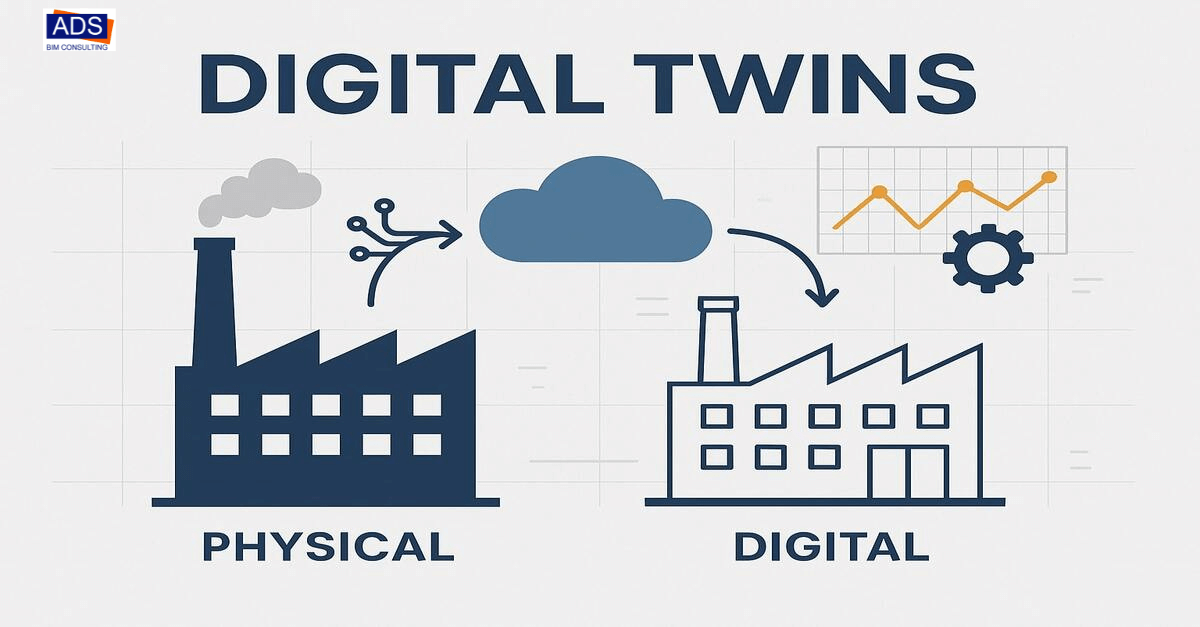The Future of Construction & Real Estate: Exploring the Power of Digital Twins
 harshu sharma
harshu sharma
Introduction
The construction and real estate industries are undergoing a digital transformation, and one of the most powerful innovations leading this change is Digital Twins. By creating virtual replicas of physical assets, Digital Twins revolutionize the way buildings and infrastructure are designed, monitored, and maintained. But what exactly are Digital Twins, and how can they benefit the AEC (Architecture, Engineering, and Construction) industry? Let’s explore.
What is a Digital Twin?
A Digital Twin is a real-time digital representation of a physical asset, process, or system. It continuously collects data from sensors, IoT devices, and BIM (Building Information Modeling) tools to create a live, interactive model that mirrors the physical counterpart.
By leveraging AI, machine learning, and big data analytics, Digital Twins help stakeholders make informed decisions, predict maintenance needs, and optimize building performance.
Key Benefits of Digital Twins in Construction & Real Estate
1. Enhanced Project Planning & Design
Digital Twins provide a dynamic simulation environment, allowing architects and engineers to visualize projects before construction begins. This leads to fewer design errors, better coordination, and improved efficiency.
2. Predictive Maintenance & Cost Reduction
Real-time data collection helps identify potential issues before they become costly problems. Facility managers can schedule maintenance proactively, reducing downtime and increasing asset lifespan.
3. Improved Sustainability & Energy Efficiency
Digital Twins optimize building operations by analyzing energy consumption patterns. This leads to lower carbon footprints and compliance with green building standards.
4. Seamless Facility Management
Once construction is complete, Digital Twins continue to serve as a powerful management tool. They provide insights into HVAC systems, security, and occupancy levels, ensuring optimal operational efficiency.
5. Enhanced Safety & Risk Management
With real-time monitoring and simulations, potential safety hazards can be identified and mitigated before accidents occur. This is crucial for high-risk projects such as skyscrapers, bridges, and tunnels.
Digital Twins & BIM: A Perfect Synergy
BIM (Building Information Modeling) and Digital Twins work hand in hand. While BIM focuses on creating intelligent 3D models for design and documentation, Digital Twins take it a step further by integrating real-time data. This synergy ensures continuous monitoring, simulation, and predictive analysis throughout the building’s lifecycle.
Real-World Applications of Digital Twins
Smart Cities: Governments use Digital Twins to enhance urban planning and traffic management.
Real Estate Management: Property owners utilize Digital Twins for remote monitoring and asset optimization.
Infrastructure Projects: Airports, bridges, and highways benefit from predictive maintenance and operational efficiency.
Healthcare Facilities: Hospitals leverage Digital Twins to streamline patient flows, improve HVAC efficiency, and enhance emergency response.
The Future of Digital Twins in AEC
As AI and IoT technologies continue to advance, Digital Twins will become more sophisticated, offering deeper insights and automation. The integration of 5G, blockchain, and cloud computing will further accelerate their adoption, making them an indispensable tool for the construction and real estate industries.
Conclusion
The Digital Twin revolution is here, transforming the AEC sector with unmatched efficiency, cost savings, and sustainability benefits. As the demand for smart buildings and infrastructure grows, companies that embrace Digital Twins will stay ahead in the competitive landscape.
Are you ready to harness the power of Digital Twins for your next project? Contact ADS BIM today to explore how we can integrate this cutting-edge technology into your workflows.
Frequently Asked Questions (FAQs)
1. How does a Digital Twin differ from BIM?
While BIM is used primarily for design and construction, Digital Twins integrate real-time data for ongoing monitoring, management, and optimization.
2. Is Digital Twin technology expensive?
The initial investment varies, but the long-term savings in maintenance, efficiency, and risk reduction far outweigh the costs.
3. Can Digital Twins be used in existing buildings?
Yes! Retroactive Digital Twins can be created using scans, sensors, and IoT devices, allowing facility managers to optimize operations.
4. What industries benefit the most from Digital Twins?
Industries like construction, real estate, healthcare, manufacturing, transportation, and energy benefit significantly from Digital Twin technology.
5. How do I get started with Digital Twins?
ADS BIM offers expert consulting, implementation, and support to help you integrate Digital Twins into your projects. Get in touch with us today!
#DigitalTwins #BIM #SmartConstruction #RealEstateTech #ConstructionInnovation #AECIndustry #BuildingTheFuture #FacilityManagement #SmartBuildings #Sustainability #PredictiveMaintenance #4DBIM #5DBIM #ADS_BIM
Learn more about BIM Services.
Explore our expertise in 4D & 5D BIM.
Check out our Scan to BIM Solutions.
Read more about Construction Documentation.
Subscribe to my newsletter
Read articles from harshu sharma directly inside your inbox. Subscribe to the newsletter, and don't miss out.
Written by

harshu sharma
harshu sharma
Build with ADS BIM Consulting Services Transform your projects with ADS BIM Consulting. Access expert solutions and advanced tools to streamline design and construction.